Google Glass. Start
Google glass. Certainly an interesting gadget, opening a new page in consumer electronics. Necessary or not, perhaps complicated, unreliable and keeps the battery a little, but it is the first one and you cannot argue with that. Or not the first ... because the idea did not come out of thin air - I will try to trace the evolution of the development of such devices that can combine an external real image with an additional, virtual one.
')
At the origins of all optical systems, imposing an additional image on the real world, are aviation sights. It was after the First World War, the aircraft began to be built with regard to aerodynamics, they began to be equipped with powerful engines, to fly fast and high, and generally stopped falling into a tailspin with each attempt to perform a maneuver.
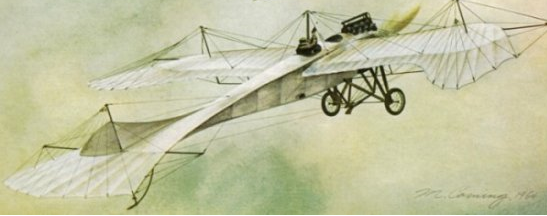
As you know, the bullet fired from a machine gun is acted upon by the force of gravity and the braking force of the air (which in this case is not taken into account). But if at the time of the shot to maneuver, and even spin around its axis - then determine in which direction to turn the line, could only the most experienced pilots.
To display the very point of impact (PIP - Predicted impact point (WikiEn) or the indicator “Forecast-track”), a fully mechanical system was developed at the beginning of the 40s, which worked according to the following principle:
Seeing the target, the pilot captured it in a ring, called ranging, because it allowed to bring the distance to the target to the “onboard system”. The algorithm of work was as follows - by pressing on the additional pedal (knee), the pilot caused the extension of the ring, which then had to be reduced to the size of the enemy plane, slightly releasing the pedal. As the pilot approached, he also increased the ring, gradually reducing the pressure on the pedal.
With the position in space it was simpler - in the mid-30s, gyroscopes were invented, thus the onboard system mechanically transmitted information to a moving lighting system. The diagram is shown in the following figure.


Since the error of the gyroscope was small, and the error of distance is insignificant (at medium distances) - the use of such systems gave an advantage to pilots who do not have much experience.
The right to be the first to invent such a device belongs to France, but in Germany it was brought to a workable version. It can also be noted that the Germans used optical bomb sights of complex construction.
The first electronic device, which used an electrolumbered tube as an indicator on the windshield (ILS - Head up display (WikiEn) , was created in the USSR 5-6 years earlier than the USA. It was installed on the MiG-15P interceptor bis. He depicted, in addition to the sight, also enemy aircraft position (obtained from radar).
The first domestic fully functional ILS stood in the cockpits of the MiG-27K, which were mass-produced in 1976–1982. Indicators on the windshield now displayed all flight information (speed, altitude, horizon line), and also transmitted images from thermal imagers (FLIR - forward looking IR - “IR camera looking forward”).
At that time, ILS was an excellent assistant in civil aviation. Special coatings allowed to increase the image contrast, reducing the transmittance of the screen at the wavelength of the imaging display. Thus, the image has become more readable in bright light.
In 1953, the first successful rocket with a thermal homing head (Wiki) AIM-9 Sidewinder was invented. The ideal weapon, built on the principle of “fired and forgotten,” it allowed to capture a target in the range of angles of ± 45 °, but the launch was usually carried out only on aircraft flying directly along the course.

The image of the turned head of homing.
(PS We have one of these missiles in the department, it is able to capture the heat radiation from an incandescent lamp or lighter and turn behind it)
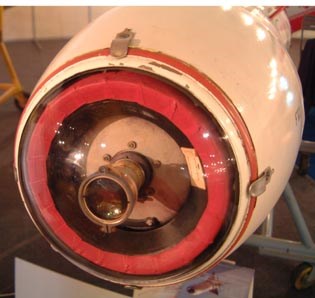
The field of view of the head without additional rotation - ~ 10 ° - therefore, it must be turned very precisely towards the target (the joystick will not work).
In 1974-78, systems were developed for the F-14 and F-15 aircraft that allow the pilot to move the GPS on the target by moving the small mark and combining the small mark. The label was projected on a small piece of glass, located in front of the eye. This was the first helmet-mounted sight.
It is worth noting that the American system was unreliable and inaccurate, therefore it was practically not used. Therefore, created in 1985, the Soviet system "SURA" can rightly be called the first mass helmet-mount. Sura was installed on MiG-25 and SU-27 aircraft and worked for the Vympel R-73 rocket. The rocket allows you to capture a target at a distance of 25-30 km.
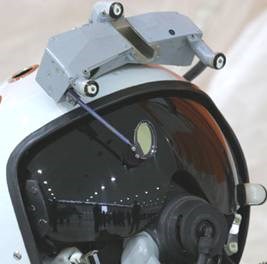
Small glass - screen, luminous lamps - positioning system
The pilot turned his head in the direction of the enemy's plane and captured the silhouette in a ring that was depicted on a piece of glass. 2 incandescent bulbs on the helmet, 2 photodetectors on the dashboard made it possible to determine the position of the gaze. (It was also possible to use electromagnetic systems, but the optical accuracy was sufficient, and the presence of additional radio emitters in the cabin would interfere with the main instruments).
Almost immediately after pointing, the pilot heard a sound signal in the earpiece and could start.

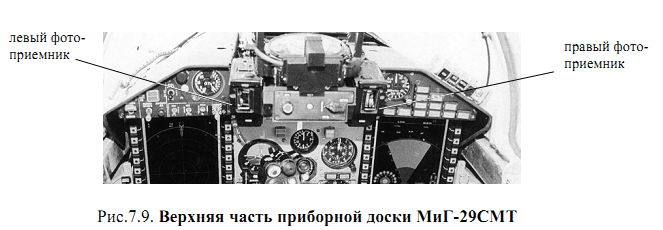
By the way, the homing missile did not necessarily explode when it hit the target. It usually exploded at a short distance (500 meters?) And covered a small area with steel balls. (in the form of a cone). Since the rocket speed is almost 5 max, the balls were piercing all possible armor.
On such a punch note, I want to go to the second part - the design .
First, please determine the notation. The most important element that combines images called combiner (in my diploma, I wrote simply - a combiner) - is responsible for adding a virtual image. This is usually a mirror with a coating that reflects the wavelength of the radiation of the display, but a cube version is possible, as in google glass.
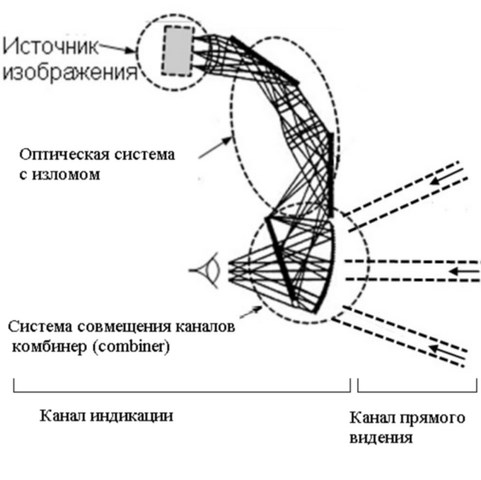
The simplest scheme is characterized by small angles and large dimensions.
According to this scheme, Google Glass and many other glasses of virtual reality, professional and entertainment sector are built.
But there is another possibility to introduce an additional image. This will reduce the size and added unique properties.
It all starts with the creation of a diffraction grating in the center layer of Dichromated Gelatin (DCG). This grating refracts radiation (which must be monochromatic) and deflects the beam towards the eye. The radiation coming from the real world has a weak effect, since this radiation consists of the entire spectrum of wavelengths.
Operating principle.
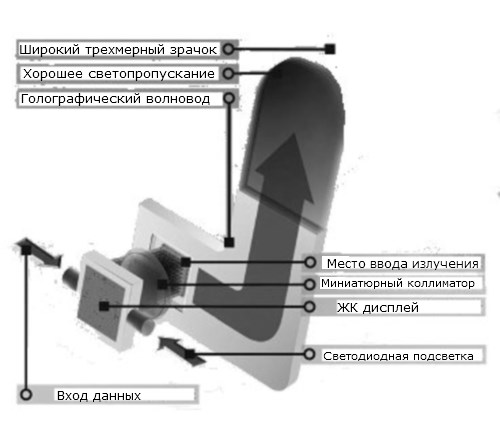
After the LCD monitor, the radiation is converted into a quasi-parallel beam and enters the plate at an angle of total internal reflection. Due to the diffraction grating located inside the plate, the beams are deflected and violate the condition of total internal reflection; thus, a wide parallel beam enters the eye and creates the idea that the image is at infinity.

Air defense violation due to the refraction of a part of the beam at the DOE.
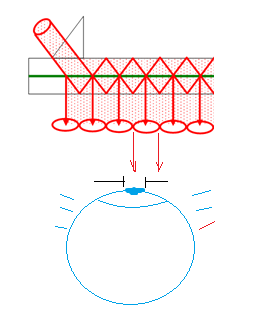
Formation of a full-fledged continuous output beam due to a complex diffraction grating.
It is worth noting that the user does not need to accurately set the helmet-mounted sight, as the eye moves, it begins to see the next beam. Perhaps there is a tracking system for the eye or the eye / brain capable of “sticking together” the two halves of the image into one - one way or another, it is easier for the user to use such an easy display.
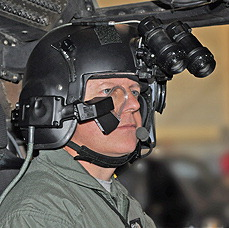
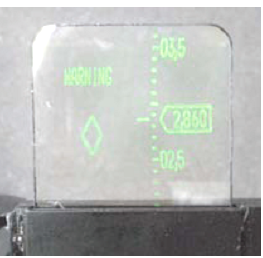
BAE has 25 years of experience creating indicators on the windshield based on DCG for EFA (eurofighter), F-22, F16 fighter jets. Now these devices are supplied to civil aircraft.
Bragg diffraction in a nutshell - under the action of an acoustic wave caused by a pasted piezoelectric source of vibration on one side and a copper plate, reflecting vibration on the other - a standing wave is obtained, which can be considered as a diffraction grating, since the refractive index in the "nodes" and "antinodes" are different .
Under certain conditions, it is possible to select one beam that can be effectively controlled.
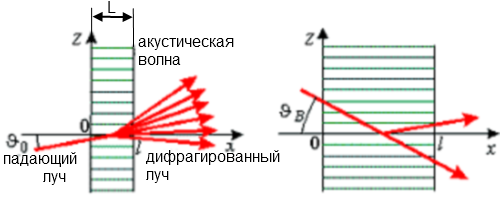
Diffraction Principle
It is possible to create an acoustic wave, both with the help of “mechanics” and directly, with the help of an electrical voltage applied to the plate. For this purpose, special transparent film electrodes are used.
By the way, self-darkening windows are built according to a similar scheme.
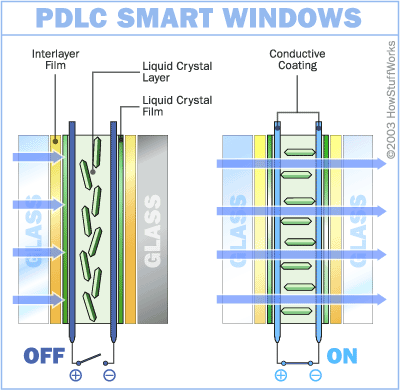
Usually, in the absence of voltage, the glass is dull.
Now imagine that this is not just a Paratellurite crystal (the material most of all deflecting rays at the same voltage), but also inside is a diffraction grating. By the way, for each wavelength a specific lattice, therefore, for a full-color image, 5 arrays are used, which are switched on one by one.
SBG Labs Inc (Switchable Bragg Grating) is located in Silicon Valley, California. First created such plates that can simultaneously focus and deflect the beam.
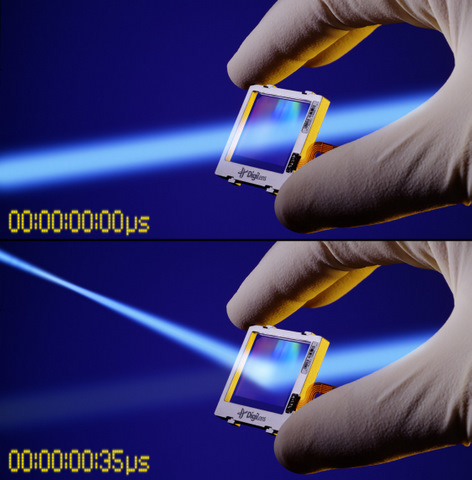
Later virtual reality glasses were created - 40 degrees field of view, 3-color - only this is a prototype and was not on sale, although it was developed in 1999.
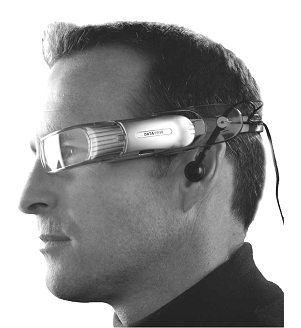
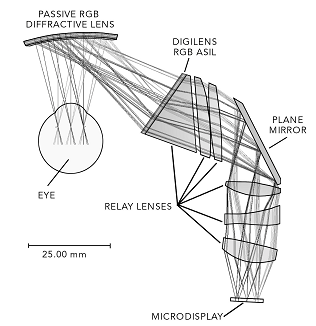
Now new glasses are at the development stage - 1080p resolution, 60 degrees field of view.

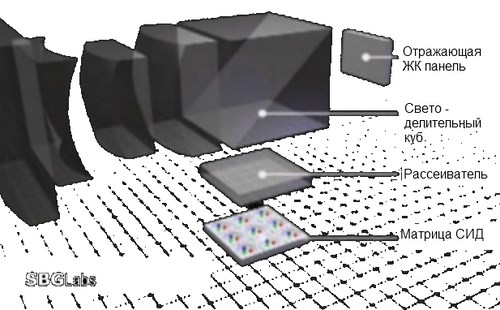

Video describing the principle of operation:
youtu.be/XkmqKeGn4yo
Apple has registered a patent for the creation of virtual reality glasses on the scheme of a laser TV .

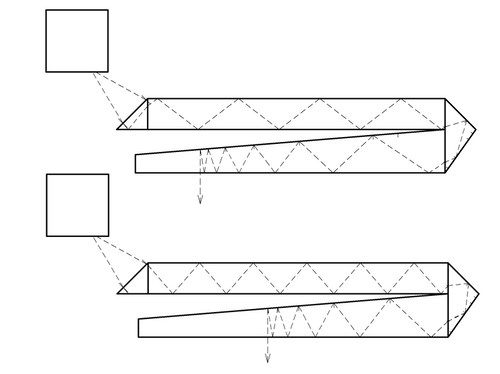
It is worth noting one advantage of such a scheme.
A system using a laser does not need a collimator. Therefore, to a person wearing Google glass, in which a “virtual” image is projected from a distance, it’s difficult to look at highly distant or close objects with this eye, the display image for him will immediately become blurry and the eye itself will try to refocus.
In Apple's “glasses,” as a laser TV is capable of projecting a clear image onto a screen at any distance, the laser beam will arrive at the retina in its original “thin” form. It is clear that if 3 lasers can still be placed behind the ear, then installing a 2-coordinate scanning system (on MEMS mirrors) on the nose is the lot of the distant future.
After discussing such giants of the global industry, it will be honest to go over to my project and consider my development.

A schematic representation of my helmet display, its photograph and optical layout in Zemax. (The prism is highly distorted, because the program shows the course of the rays and the location of the surfaces).
My device is exactly a copy of the helmet-mounted display used for 20 years in the Apache helicopter. (exactly, as my diploma is a copy of lecture materials of one southern institute (see list of references )
In my device, the radiation source is a CRT, as the most humane source of radiation — when landing a helicopter, the weight of the “headgear” slightly crushes the pilot's neck, and the high voltage cable that fell off humanely finishes it.
Thank you for readingthis to the end.
About me: 7 years ago when entering MGTU im. N.E. I chose Bauman’s optics as my specialty, namely, the design of optical systems (although I didn’t understand this right away, of course). Then I saw optical computers and photons carrying information at the speed of light. As time went on, courses alternated, the lesson from “udov” wanted to open less and less, and electrons in ordinary computers also moved at the speed of light, apparently in defiance of my dreams.
And my topic of the diploma was "Helmet target designation." Or I just said “virtual reality helmet”.
The subject of the diploma surprisingly came up with the current round of progress, and in order not to completely lose qualifications (the diploma was successfully completed 8 months ago), I decided to write a small report describing the main points of my diploma in popular language.
The May holidays were fruitful - I sat down and tried to rid the text of the diploma of official academic dryness and specific terms, or rather just rewrote it entirely.
Update 1. One curious fact is that an American pilot who constantly used a monocular display and found that he could move his eyes like a rabbit, i.e. literally read 2 books at the same time. Although in my opinion this is an evolutionary step towards progress. Source1 Source2

Update 2. A non-contact fuse question requires more data and confirmation. But 500 meters seems plausible to me because even such a distance flies in 0.5 seconds at a speed of 4 maha (* ~ 300 m / s). This information from the professor Baumanki S.B. at the lecture.
Update 3. Proximity fuze on non-nuclear antiaircraft missiles is activated at distances of up to 100 meters. Forum Thank you, fighterjet
The core warhead of the AIM-9C “Sidewinder” rocket has the following parameters: launch speed 900 m / s, damage radius 5.1 m , number of rods 144 (Source)
Aviation sights
')
At the origins of all optical systems, imposing an additional image on the real world, are aviation sights. It was after the First World War, the aircraft began to be built with regard to aerodynamics, they began to be equipped with powerful engines, to fly fast and high, and generally stopped falling into a tailspin with each attempt to perform a maneuver.

As you know, the bullet fired from a machine gun is acted upon by the force of gravity and the braking force of the air (which in this case is not taken into account). But if at the time of the shot to maneuver, and even spin around its axis - then determine in which direction to turn the line, could only the most experienced pilots.
To display the very point of impact (PIP - Predicted impact point (WikiEn) or the indicator “Forecast-track”), a fully mechanical system was developed at the beginning of the 40s, which worked according to the following principle:
Seeing the target, the pilot captured it in a ring, called ranging, because it allowed to bring the distance to the target to the “onboard system”. The algorithm of work was as follows - by pressing on the additional pedal (knee), the pilot caused the extension of the ring, which then had to be reduced to the size of the enemy plane, slightly releasing the pedal. As the pilot approached, he also increased the ring, gradually reducing the pressure on the pedal.
With the position in space it was simpler - in the mid-30s, gyroscopes were invented, thus the onboard system mechanically transmitted information to a moving lighting system. The diagram is shown in the following figure.


Since the error of the gyroscope was small, and the error of distance is insignificant (at medium distances) - the use of such systems gave an advantage to pilots who do not have much experience.
The right to be the first to invent such a device belongs to France, but in Germany it was brought to a workable version. It can also be noted that the Germans used optical bomb sights of complex construction.
The first electronic device, which used an electrolumbered tube as an indicator on the windshield (ILS - Head up display (WikiEn) , was created in the USSR 5-6 years earlier than the USA. It was installed on the MiG-15P interceptor bis. He depicted, in addition to the sight, also enemy aircraft position (obtained from radar).
The first domestic fully functional ILS stood in the cockpits of the MiG-27K, which were mass-produced in 1976–1982. Indicators on the windshield now displayed all flight information (speed, altitude, horizon line), and also transmitted images from thermal imagers (FLIR - forward looking IR - “IR camera looking forward”).
At that time, ILS was an excellent assistant in civil aviation. Special coatings allowed to increase the image contrast, reducing the transmittance of the screen at the wavelength of the imaging display. Thus, the image has become more readable in bright light.
But who needed the pilot to put this system on his head?
In 1953, the first successful rocket with a thermal homing head (Wiki) AIM-9 Sidewinder was invented. The ideal weapon, built on the principle of “fired and forgotten,” it allowed to capture a target in the range of angles of ± 45 °, but the launch was usually carried out only on aircraft flying directly along the course.

The image of the turned head of homing.
(PS We have one of these missiles in the department, it is able to capture the heat radiation from an incandescent lamp or lighter and turn behind it)

The field of view of the head without additional rotation - ~ 10 ° - therefore, it must be turned very precisely towards the target (the joystick will not work).
In 1974-78, systems were developed for the F-14 and F-15 aircraft that allow the pilot to move the GPS on the target by moving the small mark and combining the small mark. The label was projected on a small piece of glass, located in front of the eye. This was the first helmet-mounted sight.
It is worth noting that the American system was unreliable and inaccurate, therefore it was practically not used. Therefore, created in 1985, the Soviet system "SURA" can rightly be called the first mass helmet-mount. Sura was installed on MiG-25 and SU-27 aircraft and worked for the Vympel R-73 rocket. The rocket allows you to capture a target at a distance of 25-30 km.

Small glass - screen, luminous lamps - positioning system
The work algorithm was as follows:
The pilot turned his head in the direction of the enemy's plane and captured the silhouette in a ring that was depicted on a piece of glass. 2 incandescent bulbs on the helmet, 2 photodetectors on the dashboard made it possible to determine the position of the gaze. (It was also possible to use electromagnetic systems, but the optical accuracy was sufficient, and the presence of additional radio emitters in the cabin would interfere with the main instruments).
Almost immediately after pointing, the pilot heard a sound signal in the earpiece and could start.


By the way, the homing missile did not necessarily explode when it hit the target. It usually exploded at a short distance (500 meters?) And covered a small area with steel balls. (in the form of a cone). Since the rocket speed is almost 5 max, the balls were piercing all possible armor.
On such a punch note, I want to go to the second part - the design .
First, please determine the notation. The most important element that combines images called combiner (in my diploma, I wrote simply - a combiner) - is responsible for adding a virtual image. This is usually a mirror with a coating that reflects the wavelength of the radiation of the display, but a cube version is possible, as in google glass.

The simplest scheme is characterized by small angles and large dimensions.
According to this scheme, Google Glass and many other glasses of virtual reality, professional and entertainment sector are built.
But there is another possibility to introduce an additional image. This will reduce the size and added unique properties.
Q-sight from BAE systems.
It all starts with the creation of a diffraction grating in the center layer of Dichromated Gelatin (DCG). This grating refracts radiation (which must be monochromatic) and deflects the beam towards the eye. The radiation coming from the real world has a weak effect, since this radiation consists of the entire spectrum of wavelengths.
Operating principle.

After the LCD monitor, the radiation is converted into a quasi-parallel beam and enters the plate at an angle of total internal reflection. Due to the diffraction grating located inside the plate, the beams are deflected and violate the condition of total internal reflection; thus, a wide parallel beam enters the eye and creates the idea that the image is at infinity.

Air defense violation due to the refraction of a part of the beam at the DOE.

Formation of a full-fledged continuous output beam due to a complex diffraction grating.
It is worth noting that the user does not need to accurately set the helmet-mounted sight, as the eye moves, it begins to see the next beam. Perhaps there is a tracking system for the eye or the eye / brain capable of “sticking together” the two halves of the image into one - one way or another, it is easier for the user to use such an easy display.


BAE has 25 years of experience creating indicators on the windshield based on DCG for EFA (eurofighter), F-22, F16 fighter jets. Now these devices are supplied to civil aircraft.
2 "complex" version of the combination system. On Bragg diffraction
Bragg diffraction in a nutshell - under the action of an acoustic wave caused by a pasted piezoelectric source of vibration on one side and a copper plate, reflecting vibration on the other - a standing wave is obtained, which can be considered as a diffraction grating, since the refractive index in the "nodes" and "antinodes" are different .
Under certain conditions, it is possible to select one beam that can be effectively controlled.

Diffraction Principle
It is possible to create an acoustic wave, both with the help of “mechanics” and directly, with the help of an electrical voltage applied to the plate. For this purpose, special transparent film electrodes are used.
By the way, self-darkening windows are built according to a similar scheme.

Usually, in the absence of voltage, the glass is dull.
Now imagine that this is not just a Paratellurite crystal (the material most of all deflecting rays at the same voltage), but also inside is a diffraction grating. By the way, for each wavelength a specific lattice, therefore, for a full-color image, 5 arrays are used, which are switched on one by one.
SBG Labs Inc (Switchable Bragg Grating) is located in Silicon Valley, California. First created such plates that can simultaneously focus and deflect the beam.

Later virtual reality glasses were created - 40 degrees field of view, 3-color - only this is a prototype and was not on sale, although it was developed in 1999.


Now new glasses are at the development stage - 1080p resolution, 60 degrees field of view.



Video describing the principle of operation:
youtu.be/XkmqKeGn4yo
Apple glasses
Apple has registered a patent for the creation of virtual reality glasses on the scheme of a laser TV .


It is worth noting one advantage of such a scheme.
A system using a laser does not need a collimator. Therefore, to a person wearing Google glass, in which a “virtual” image is projected from a distance, it’s difficult to look at highly distant or close objects with this eye, the display image for him will immediately become blurry and the eye itself will try to refocus.
In Apple's “glasses,” as a laser TV is capable of projecting a clear image onto a screen at any distance, the laser beam will arrive at the retina in its original “thin” form. It is clear that if 3 lasers can still be placed behind the ear, then installing a 2-coordinate scanning system (on MEMS mirrors) on the nose is the lot of the distant future.
After discussing such giants of the global industry, it will be honest to go over to my project and consider my development.

A schematic representation of my helmet display, its photograph and optical layout in Zemax. (The prism is highly distorted, because the program shows the course of the rays and the location of the surfaces).
My device is exactly a copy of the helmet-mounted display used for 20 years in the Apache helicopter. (exactly, as my diploma is a copy of lecture materials of one southern institute (see list of references )
In my device, the radiation source is a CRT, as the most humane source of radiation — when landing a helicopter, the weight of the “headgear” slightly crushes the pilot's neck, and the high voltage cable that fell off humanely finishes it.
Thank you for reading
About me: 7 years ago when entering MGTU im. N.E. I chose Bauman’s optics as my specialty, namely, the design of optical systems (although I didn’t understand this right away, of course). Then I saw optical computers and photons carrying information at the speed of light. As time went on, courses alternated, the lesson from “udov” wanted to open less and less, and electrons in ordinary computers also moved at the speed of light, apparently in defiance of my dreams.
And my topic of the diploma was "Helmet target designation." Or I just said “virtual reality helmet”.
The subject of the diploma surprisingly came up with the current round of progress, and in order not to completely lose qualifications (the diploma was successfully completed 8 months ago), I decided to write a small report describing the main points of my diploma in popular language.
The May holidays were fruitful - I sat down and tried to rid the text of the diploma of official academic dryness and specific terms, or rather just rewrote it entirely.
Update 1. One curious fact is that an American pilot who constantly used a monocular display and found that he could move his eyes like a rabbit, i.e. literally read 2 books at the same time. Although in my opinion this is an evolutionary step towards progress. Source1 Source2

Update 2. A non-contact fuse question requires more data and confirmation. But 500 meters seems plausible to me because even such a distance flies in 0.5 seconds at a speed of 4 maha (* ~ 300 m / s). This information from the professor Baumanki S.B. at the lecture.
Update 3. Proximity fuze on non-nuclear antiaircraft missiles is activated at distances of up to 100 meters. Forum Thank you, fighterjet
The core warhead of the AIM-9C “Sidewinder” rocket has the following parameters: launch speed 900 m / s, damage radius 5.1 m , number of rods 144 (Source)
Bibliography:
Books that will be useful to those interested in aviation and, in particular, helmet-mounted displays:
1. Onboard information systems: Course of lectures: A.A. 2004 (The only material in the Russian language. Despite the late period of publication is relevant)
2. Wiley - Military Avionics Systems (2006)
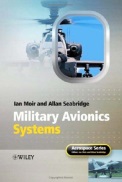
3. Advanced Avionics Handbook (for pilots, “how to use an airplane”)
4. British Aircraft Armament (read here, about the "mechanical sight". - The last Appendix B)

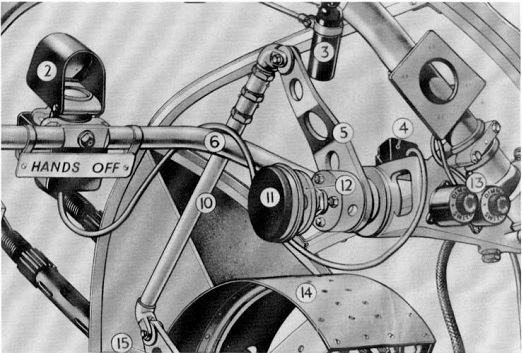
Original photo
Frankly, I am not sure in some small details, so I will be glad to any comments.
1. Onboard information systems: Course of lectures: A.A. 2004 (The only material in the Russian language. Despite the late period of publication is relevant)
2. Wiley - Military Avionics Systems (2006)

3. Advanced Avionics Handbook (for pilots, “how to use an airplane”)
4. British Aircraft Armament (read here, about the "mechanical sight". - The last Appendix B)


Original photo
Frankly, I am not sure in some small details, so I will be glad to any comments.
Source: https://habr.com/ru/post/178803/
All Articles